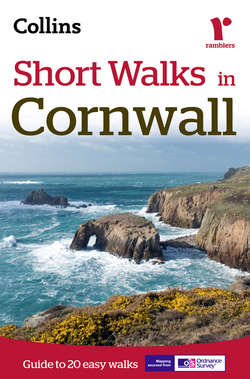Читать книгу Short Walks in Cornwall - Collins Maps - Страница 11
Human history
ОглавлениеIn the warmer conditions after the Ice Age, all Cornwall except the highest ground became covered by forest. Mesolithic (Mid Stone Age) Man, who inhabited the land, was probably a nomadic hunter and fisherman. In about 3500BC Neolithic (New Stone Age) settlers arrived from the Atlantic seaboard of Europe. They used a variety of stone tools and weapons and founded settlements in forest clearings. Monuments of the Neolithic and Early Bronze Age people are the stone chamber tombs used for communal burials, known as quoits. Surmounted by huge stone slabs and covered originally by earthen mounds, there are a number to be found in Cornwall, including Lanyon Quoit seen on the Men-an-Tol walk. In about 2000BC the Beaker Folk arrived, bringing with them the knowledge of the working of metals. It was they who erected the imposing stone circles and standing stones all over Cornwall. Examples are the Merry Maidens and the Pipers.
The next migrants to reach southern Britain in about 700BC were the Iron Age Celts from northwest Europe. Organised in clans, they were constantly warring among themselves. Characteristic signs of this occupation are hill forts and cliff castles, several of which are passed on walks in this guide. They all feature a steep headland fortified by one or more ramparts, usually built across the narrowest part of the promontory, and The Rumps near Pentire is a good example.
Roman legions landed in Britain in AD43 but do not appear to have bothered much about the small isolated communities in Cornwall, so Roman remains are sparse. After the departure of the Romans in AD410 the Anglo Saxons pushed the Celts into the Welsh mountains and to Cornwall. Many of those reaching Cornwall then crossed to their fellow Celts in France, but others remained, forming a community in Cornwall. The 5th and 6th centuries were remarkable for the number of Welsh, Irish and Breton Christian missionaries who came over to Cornwall, giving many unusual saints’ names to churches, towns and villages.
Cornwall had only been a part of Anglo Saxon England for just over 100 years when William the Conqueror landed at Pevensey Bay. By 1072 Cornwall was in Norman hands. The first towns in Cornwall began to spring up and other outward signs of Norman rule began to appear, notably Norman churches.
As with the rest of England, the structure of Cornish life was feudal and the landed gentry built substantial farmhouses. Growing prosperity and settled conditions, coupled with the religious fervour of the Cornish, resulted in a burst of church rebuilding. We owe many of the beautiful 15th century Cornish churches which remain today to this period. The Cornish gentry were wholeheartedly Royalist in the Civil War, and their men followed them into battle. In 1645, however, Cromwell’s well-trained forces moved westward and, when Pendennis Castle and St Michael’s Mount surrendered after long sieges, the Royalist cause in Cornwall was lost.
With King William III on the throne, Britain seemed to be set for quieter times. Cornwall had a flourishing fishing industry but from 1700 onwards it was mining that developed fastest. Shaft after shaft was sunk to extract ores, and, by the mid 18th century, Cornwall was the largest supplier of copper in the world. The copper boom lasted to about 1870. With new and cheaper sources being discovered abroad, the Cornish mines began to close. The dozens of derelict engine and boiler houses left behind are a familiar feature of the Cornish landscape today and they give an insight into the enormous scale of this industry in what are now relatively remote places. Several of the walks in this guide – St Agnes to Porthtowan, Cotehele and Calstock, Cape Cornwall and Levant, and Luxulyan – fall within areas designated under the Cornwall and West Devon Mining Landscape World Heritage Site.
Cornwall’s other traditional industry suffered a severe blow at about the same time as mining. The pilchard shoals, which provided a livelihood for so many fishing villages, disappeared from the coastal waters. There were still mackerel and other fish but there were no longer salted pilchards to send abroad in quantities. Cornish fishing has never fully recovered. In the latter half of the 19th century, the bleak outlook for Cornwall was transformed by the arrival of the railway. Fish, early vegetables and flowers were taken speedily to London and other centres. In the summer, Victorian holidaymakers began to discover the attractions of Cornwall’s magnificent coastline and laid the foundations of the present thriving tourist trade.
